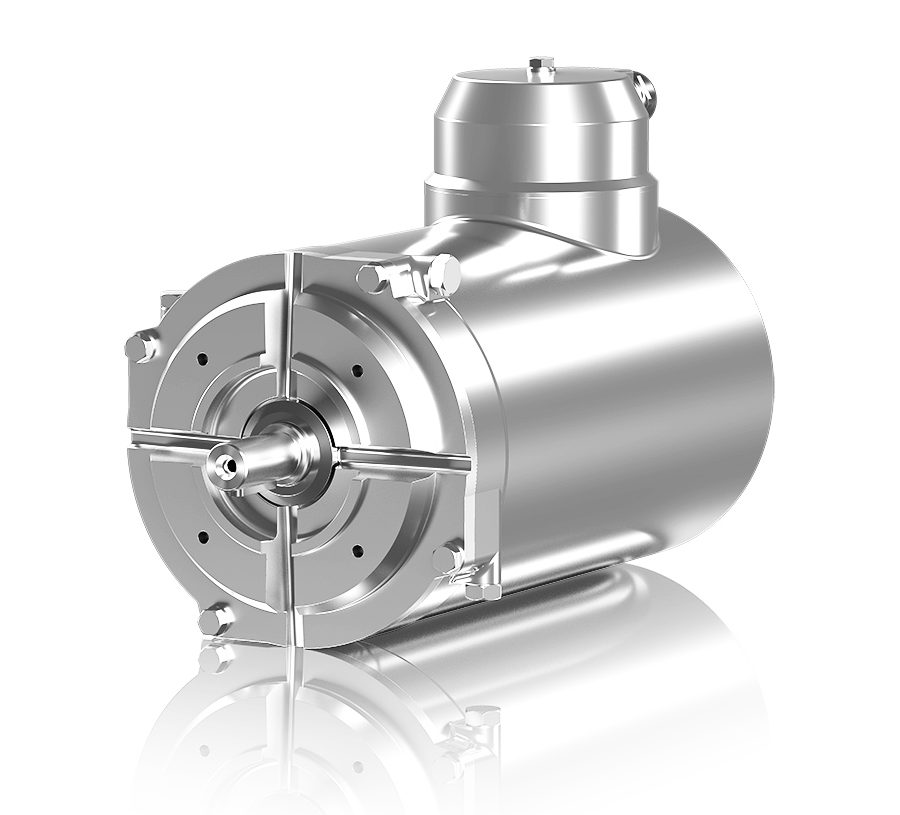
Benefits of stainless steel washdown motors
by William V. Schrottky, Technical Writer, eMotors Direct Inc.

Stainless steel washdown motors provide the best characteristics for any application that requires frequent washdowns with minimum downtime

PHOTO: IEC Food Safe stainless steel motor/ABB
—Sponsored article by eMotors
With the advent of advanced industrial automation and control systems, many companies are making extensive use of motors in pumps and other applications to cut costs and increase efficiency to drive revenue. In applications that are sensitive to contamination, such as food manufacturing and pharmaceuticals, strict hygiene requirements mean that motors are often operating in a washdown environment and regularly coming into contact with high-pressure, high-temperature water jets that are often combined with caustic cleaning chemicals.
To avoid subsequent damage to the motor, including surface damage that provides opportunities for contamination to build up, companies require motors that are designed and built specifically to withstand a washdown environment. Stainless steel washdown motors provide the best characteristics for any application that requires frequent washdowns with a minimum of downtime.
Contamination is a serious issue in a range of industries where electric motors operate in close proximity to food and other biologically sensitive products. In the meat industry, where chicken, beef and bacon are processed, equipment that comes into contact with food must be thoroughly cleaned to prevent build-up of particles that can provide an opportunity for harmful bacteria such as salmonella and listeria to grow. Pharmaceutical manufacturing requires an even higher degree of care to ensure that products are manufactured in a sterile environment that is free from impurities. Mistakes can be disastrous, not just for consumers but also the companies themselves, who must initiate costly product recalls that result in massive revenue losses and lasting damage to brands and reputations.
Due to the amount of preparation required, cleaning schedules that meet strict hygiene requirements set by regulators commonly mean significant downtime and loss of productivity. To begin with, motors often don’t have a smooth exterior, and feature many crevices and other places that are difficult to access where food particles can build up. This requires them to be disassembled and reassembled during cleaning, which takes a significant amount of time. Measures must also be taken to prevent moisture and contamination from entering the motor through bearings and seals and corroding the interior surfaces and windings. This complexity and lost productivity can have a substantial impact on a company’s bottom line.
Even with plenty of preparation, the humid, wet and corrosive environment takes its toll on motors and often drastically reduces their service life, requiring regular maintenance and parts replacement that result in massively increased cost. To meet this challenge, the washdown duty motor has been developed specifically to operate in this environment.
Washdown duty motors are motors that are designed to be washed down and cleaned in-place. They are typically IP69-certified, which means that they are able to withstand direct contact with high-pressure, high-temperature water and steam jets. They feature extra design to prevent moisture from entering the motor, including sealed bearings with moisture-resistant lubrication as well as gaskets and oil seals that provide a barrier to liquids and moisture-laden air. On the inside, the windings may also be of corrosion-resistant materials, and some motors even come with the windings fully encased in a moisture-resistant potting compound as further protection.
Additionally, the exterior (and often the interior as well) of the motor housing usually features a glossy, smooth protective coating that is designed to maximize resistance to cracks, chips and chemical degradation. In contamination-sensitive industries, the paint must also be certified as safe for the application, and the coating must be always in top condition without even small areas of damage that might allow corrosion to spread and allow contaminated particles to be trapped.
Even the best paints, however, are limited in their ability to withstand the wear and tear of industrial environments, whether from scrapes and impacts or direct contact with corrosive cleaning chemicals. Ideally, a motor would not need a protective coating at all, but standard materials used to manufacture motors, such as cast iron, steel and aluminum, readily corrode when exposed to a washdown environment.
In recent years, stainless steel washdown motors have come into favor due to the exceptional characteristics of stainless steel to withstand even the harshest washdown conditions. Stainless steel resists both chemical and water corrosion and does not require any protective coating, which means that there is no paint layer that might become damaged and allow corrosion to spread. With a shiny, smooth, paint-free finish, stainless steel washdown motors provide very little opportunity for particle build-up and are ideal for applications where washing and cleaning is frequently necessary.
Stainless steel washdown motors are generally more expensive than their counterparts, and when cleaning is only occasionally required, a standard washdown motor may be sufficient. However, some applications require such a high level of sanitisation that stainless steel is the only viable option. Many high-quality motors also come with stainless steel accessories, such as the conduit box, base and fan cover, to make it easier to clean the motor in place. Laser-engraved rating plates are another common feature that eliminates the need for attached plates that can trap contamination underneath.
Unless motors are designed specifically for washdown environments, they suffer corrosion damage from contact with water and chemicals and a short service life. Among washdown duty motors, stainless steel motors offer very high resistance to corrosion without the need for a protective coating, making them ideal for applications where the motor must be frequently cleaned in place to maintain a high level of hygiene.